Stacks are not just a buzzword – they are essential for tackling complex problems in a simple way in your programs. Whether it’s undoing actions in your text editor or managing function calls, understanding stacks can make a big difference.
A stack is a type of data structure that operates on a Last-In, First-Out (LIFO) principle. This might sound technical, but imagine a stack of plates.
You place a plate on top of another, and when you need one, you grab the topmost plate.
That’s how a stack works. The last item you add is the first one you take out.
Why does this matter? Because in programming, we often need to manage data in a way where the most recent piece of information is handled first.
Stacks come in handy in several scenarios:
- Function calls: When a function calls another function, the current function is paused and placed on the stack.
- Undo operations: Many applications use stacks to keep track of your last actions.
- Expression evaluation: Converting infix expressions to postfixes or prefixes often relies on stacks.
Knowing how to implement and use stack operations in data structure effectively can help us solve these problems more efficiently.
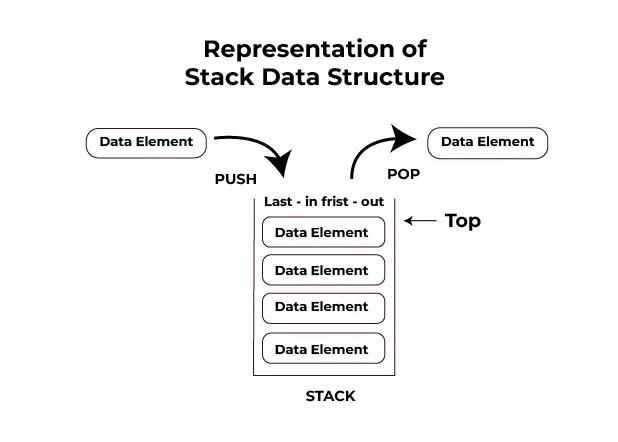
Detailed Explanation of the Last-In-First-Out (LIFO) Principle with Real-Life Analogies
Let’s dive deeper into LIFO.
Consider an example – imagine you’re packing a suitcase. You place items one by one. When you arrive at your destination, you open the suitcase and need to grab something.
What do you get first? It’s the last item you packed.
This is the core of the LIFO principle. In computer science, LIFO is crucial because it allows us to control the flow of data effectively:
- Function Stack: Every time a function is called, it’s placed on the stack. When the function completes, it’s removed from the stack, and the control returns to the previous function.
- Browser History: When we navigate through web pages, the most recent page is the first to go when we hit the back button.
This principle is not just theoretical; it’s something we interact with daily, even if we don’t always realize it.

POSTGRADUATE PROGRAM IN
Multi Cloud Architecture & DevOps
Master cloud architecture, DevOps practices, and automation to build scalable, resilient systems.
Comprehensive Overview of Basic Operations in Stack Data Structures
Understanding stack operations is the key to mastering this data structure. Let’s break down the essential operations: push, pop, peek, isEmpty, isFull, and size.
Push Operation: Adding Elements to the Stack
The push operation is how we add items to a stack.
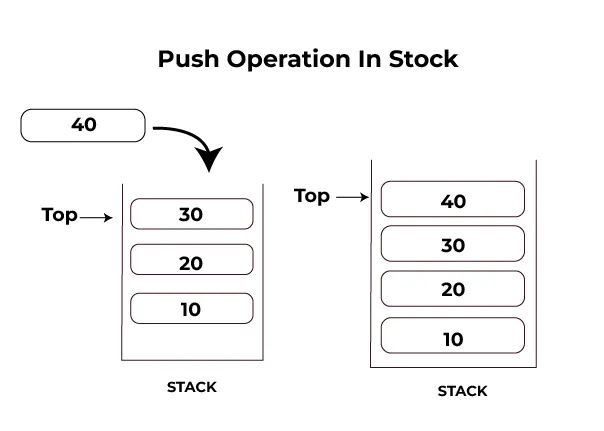
Imagine we’re stacking books. When we push a new book, it goes right on top of the stack. Here’s how we might code this in Java:
import java.util.Scanner;
class Stack {
static final int MAX = 1000;
int top;
int[] stack = new int[MAX];
Stack() {
top = -1;
}
void push(int x) {
if (top >= MAX - 1) {
System.out.println("Stack Overflow");
return;
}
stack[++top] = x;
System.out.println(x + " pushed into stack");
}
public static void main(String[] args) {
Stack s = new Stack();
Scanner scanner = new Scanner(System.in);
System.out.print("Enter the number of elements to push: ");
int n = scanner.nextInt();
for (int i = 0; i < n; i++) {
System.out.print("Enter element " + (i + 1) + ": ");
int element = scanner.nextInt();
s.push(element);
}
scanner.close();
}
}
Output:
Enter the number of elements to push: 5
Enter element 1: 2
2 pushed into stack
Enter element 2: 7
7 pushed into stack
Enter element 3: 4
4 pushed into stack
Enter element 4: 8
8 pushed into stack
Enter element 5: 3
3 pushed into stack
Pop Operation: Removing Elements from the Stack
Now, let’s talk about removing elements – the pop operation. When we pop an item, we’re taking off the last thing we added.

Imagine it as removing the top book from our stack. Here’s how the pop function looks in Java:
class Stack {
static final int MAX = 1000;
int top;
int[] stack = new int[MAX];
Stack() {
top = -1;
}
void push(int x) {
if (top >= MAX - 1) {
System.out.println("Stack Overflow");
return;
}
stack[++top] = x;
System.out.println(x + " pushed into stack");
}
int pop() {
if (top < 0) {
System.out.println("Stack Underflow");
return -1;
}
return stack[top--];
}
public static void main(String[] args) {
Stack s = new Stack();
s.push(5);
s.push(10);
s.push(15);
System.out.println("Popped: " + s.pop()); // Output: Popped: 15
}
}
Output:
5 pushed into stack
10 pushed into stack
15 pushed into stack
Popped: 15
Peek/Top Operation: Accessing the Top Element of the Stack
Sometimes, we just want to see what’s on top without removing it. That’s where the peek operation comes in.
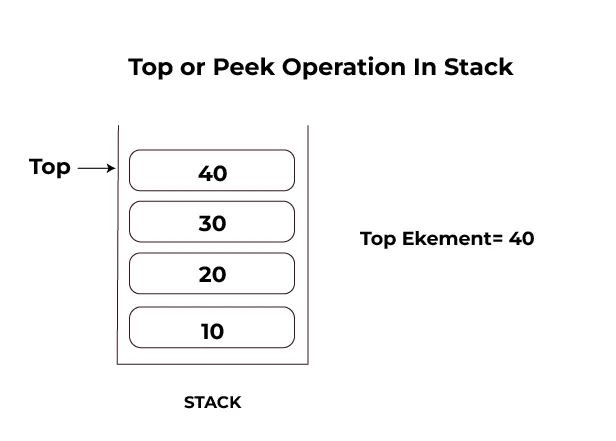
Here’s how we can implement this in Java:
Peek/Top Operation: Accessing the Top Element of the Stack
class Stack {
static final int MAX = 1000;
int top;
int[] stack = new int[MAX];
Stack() {
top = -1;
}
void push(int x) {
if (top >= MAX - 1) {
System.out.println("Stack Overflow");
return;
}
stack[++top] = x;
System.out.println(x + " pushed into stack");
}
int pop() {
if (top < 0) {
System.out.println("Stack Underflow");
return -1;
}
return stack[top--];
}
int peek() {
if (top < 0) {
System.out.println("Stack is empty");
return -1;
}
return stack[top];
}
public static void main(String[] args) {
Stack s = new Stack();
s.push(10);
s.push(20);
System.out.println("Top element is: " + s.peek()); // Output: Top element is: 20
}
}
Output:
10 pushed into stack
20 pushed into stack
Top element is: 20
isEmpty Operation: Checking if the Stack is Empty
Before performing operations like pop or peek, it’s good to know if our stack is empty. This prevents errors and keeps our programs running smoothly.
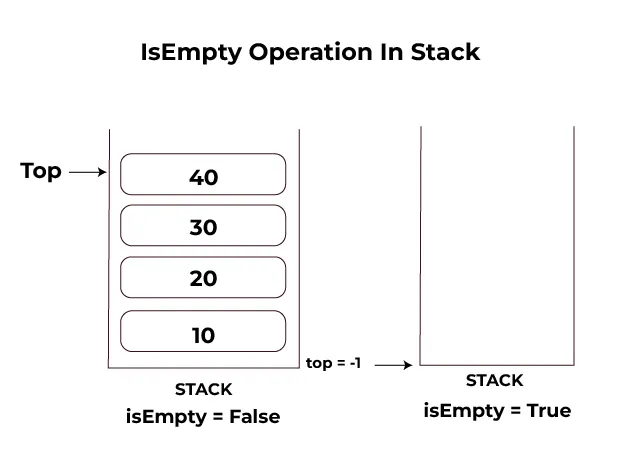
Here’s a quick Java example:
class Stack {
static final int MAX = 1000;
int top;
int[] stack = new int[MAX];
Stack() {
top = -1;
}
void push(int x) {
if (top >= MAX - 1) {
System.out.println("Stack Overflow");
return;
}
stack[++top] = x;
System.out.println(x + " pushed into stack");
}
boolean isEmpty() {
return top == -1;
}
public static void main(String[] args) {
Stack s = new Stack();
System.out.println("Stack is empty: " + s.isEmpty()); // Output: Stack is empty: true
s.push(10);
System.out.println("Stack is empty: " + s.isEmpty()); // Output: Stack is empty: false
}
}
Output:
Stack is empty: true
10 pushed into stack
Stack is empty: false
This simple check returns true if the stack is empty and false otherwise. It’s a small but essential operation to ensure we’re not trying to pop from an empty stack.
isFull Operation: Checking if the Stack is Full
In cases where our stack has a fixed size, we need to check if it’s full before pushing new elements.
Here’s how this looks in Java:
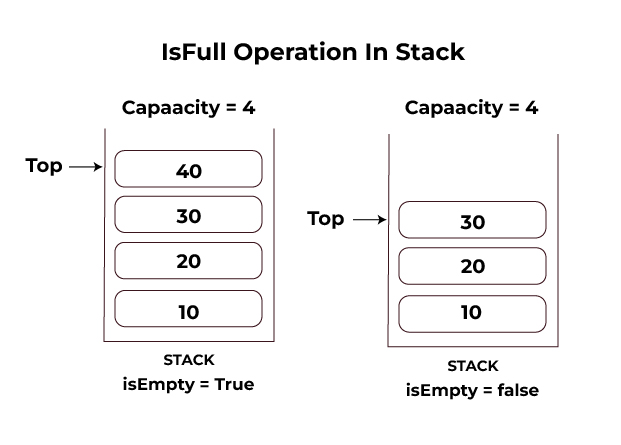
class Stack {
static final int MAX = 1000;
int top;
int[] stack = new int[MAX];
Stack() {
top = -1;
}
void push(int x) {
if (top >= MAX - 1) {
System.out.println("Stack Overflow");
return;
}
stack[++top] = x;
System.out.println(x + " pushed into stack");
}
boolean isFull() {
return top == MAX - 1;
}
boolean isEmpty() {
return top == -1;
}
public static void main(String[] args) {
Stack s = new Stack();
System.out.println("Stack is empty: " + s.isEmpty()); // Output: Stack is empty: true
s.push(10);
s.push(20);
System.out.println("Stack is full: " + s.isFull()); // Output: Stack is full: false
}
}
Output:
Stack is empty: true
10 pushed into stack
20 pushed into stack
Stack is full: false
This function ensures we’re not pushing elements onto an already full stack, preventing overflow errors.
Size Operation: Determining the Number of Elements in the Stack
Finally, let’s determine how many items are currently in our stack. This is useful when we need to know the stack’s capacity at any given moment.
Here’s a Java code example:
class Stack {
static final int MAX = 1000; // Maximum size of the stack
int top;
int[] stack = new int[MAX];
// Constructor to initialise the stack
Stack() {
top = -1;
}
// Method to add an element to the stack
void push(int x) {
if (top >= MAX - 1) {
System.out.println("Stack Overflow");
return;
}
stack[++top] = x;
System.out.println(x + " pushed into stack");
}
// Method to check if the stack is full
boolean isFull() {
return top == MAX - 1;
}
// Method to check if the stack is empty
boolean isEmpty() {
return top == -1;
}
// Method to get the current size of the stack
int size() {
return top + 1;
}
public static void main(String[] args) {
Stack s = new Stack();
System.out.println("Stack is empty: " + s.isEmpty()); // Output: Stack is empty: true
s.push(10);
s.push(20);
System.out.println("Stack size is: " + s.size()); // Output: Stack size is: 2
System.out.println("Stack is full: " + s.isFull()); // Output: Stack is full: false
}
}
Output:
Stack is empty: true
10 pushed into stack
20 pushed into stack
Stack size is: 2
Stack is full: false
This function quickly returns the current size of the stack, letting us manage our data more effectively.
Handling Edge Cases in Stack Implementations: Overflow and Underflow Conditions
When working with stack operations in data structures, two major concerns often pop up: overflow and underflow.
What happens when we try to push an element onto a stack that’s already full? Or when we attempt to pop from an empty stack? These situations can cause our programs to crash or behave unpredictably.
Let’s dive into these edge cases and how we can handle them effectively.
What is Stack Overflow?
A stack overflow occurs when we try to add more elements to a stack that has reached its maximum capacity.
It’s like trying to stack one more book on a shelf that’s already full. There’s simply no room left.
In an array-based stack implementation, we define a fixed size. Once that limit is hit, any further push operation can lead to an overflow error.
This is not just a theoretical problem; it’s something we need to anticipate and manage.
Example:
class Stack {
static final int MAX = 3; // Setting a small stack size for demonstration
int top;
int[] stack = new int[MAX];
Stack() {
top = -1;
}
void push(int x) {
if (top >= MAX - 1) {
System.out.println("Stack Overflow");
return;
}
stack[++top] = x;
System.out.println(x + " pushed into stack");
}
public static void main(String[] args) {
Stack s = new Stack();
s.push(5);
s.push(10);
s.push(15);
s.push(20); // This push will cause overflow
}
}
Output:
5 pushed into stack
10 pushed into stack
15 pushed into stack
Stack Overflow
Notice how the code gracefully handles the overflow by printing an error message instead of crashing.
What is Stack Underflow?
Stack underflow is the opposite problem. It happens when we try to pop an element from an empty stack. It’s like trying to grab a book from an already empty shelf – there’s nothing to take.
This can occur when we’ve removed all elements, but the program still attempts to pop more. Handling underflow properly is crucial to prevent unexpected behaviour in our applications.
Example:
import java.util.ArrayList;
class Stack {
private ArrayList<Integer> stack;
Stack() {
stack = new ArrayList<>();
}
void push(int x) {
stack.add(x);
}
String pop() {
if (stack.isEmpty()) {
return "Stack Underflow";
}
return String.valueOf(stack.remove(stack.size() - 1));
}
public static void main(String[] args) {
Stack s = new Stack();
System.out.println("Pop\t" + s.pop()); // Output: Stack Underflow
s.push(10);
System.out.println("Pop\t" + s.pop()); // Output: 10
System.out.println("Pop\t" + s.pop()); // Output: Stack Underflow
}
}
Output:
Pop Stack Underflow
Pop 10
Pop Stack Underflow
We see here how the code handles attempts to pop from an empty stack by returning a clear underflow message.

82.9%
of professionals don't believe their degree can help them get ahead at work.
Implementing a Stack Using Arrays
Array-based stacks are straightforward but come with the risk of overflow, as we’ve just seen. Let’s walk through a basic implementation.
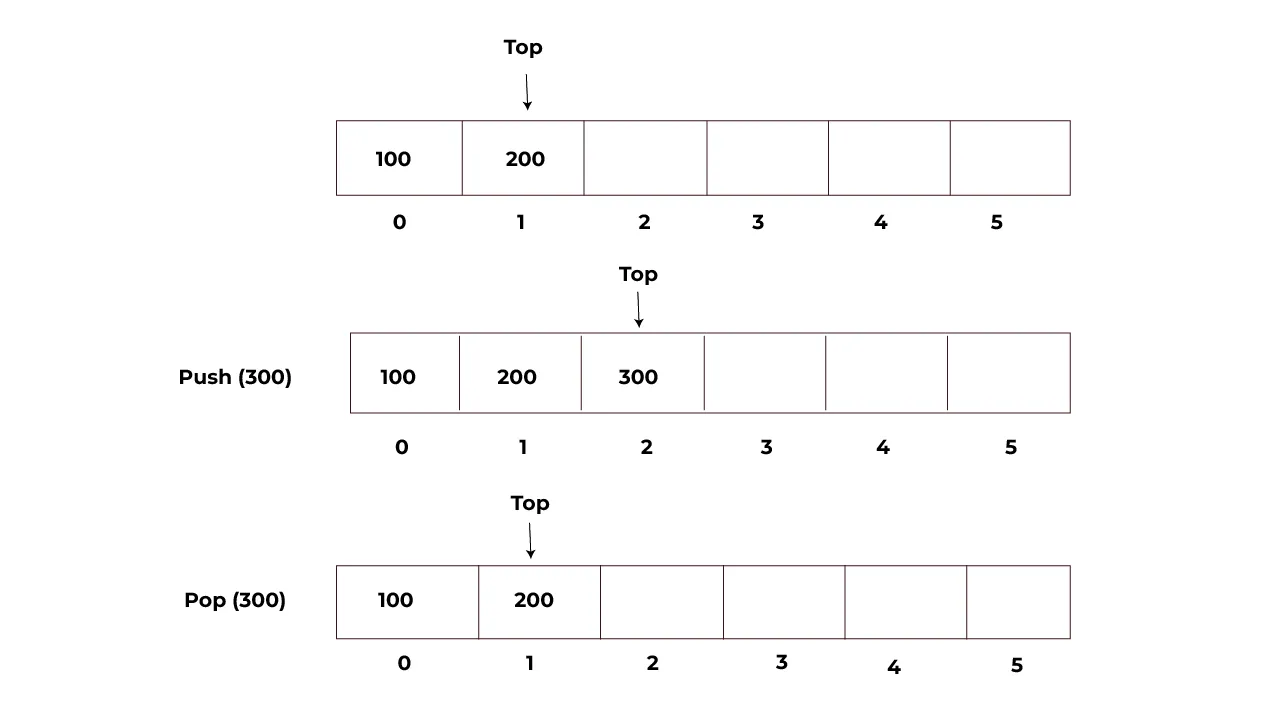
Array-Based Stack Implementation:
class Stack {
static final int MAX = 1000;
int top;
int[] stack = new int[MAX];
Stack() {
top = -1;
}
void push(int x) {
if (top >= MAX - 1) {
System.out.println("Stack Overflow");
return;
}
stack[++top] = x;
System.out.println("Push\t" + x + " pushed into stack");
}
int pop() {
if (top < 0) {
System.out.println("Stack Underflow");
return -1;
}
return stack[top--];
}
int peek() {
if (top < 0) {
System.out.println("Stack is empty");
return -1;
}
return stack[top];
}
boolean isEmpty() {
return top < 0;
}
public static void main(String[] args) {
Stack s = new Stack();
s.push(10);
s.push(20);
s.push(30);
System.out.println("Peek\tTop element is: " + s.peek());
System.out.println("Pop\tPopped element: " + s.pop());
System.out.println("Is Empty\tStack is empty: " + (s.isEmpty() ? "Yes" : "No"));
}
}
Output:
Push 10 pushed into stack
Push 20 pushed into stack
Push 30 pushed into stack
Peek Top element is: 30
Pop Popped element: 30
Is Empty Stack is empty: No
This code snippet includes pushing, popping, peeking, and checking if the stack is empty.
Implementing a Stack Using Linked Lists
Linked lists offer a more flexible alternative to arrays for implementing stacks. With linked lists, our stack can grow and shrink as needed without worrying about a predefined size.
This flexibility means we avoid overflow, but we still need to manage underflow.
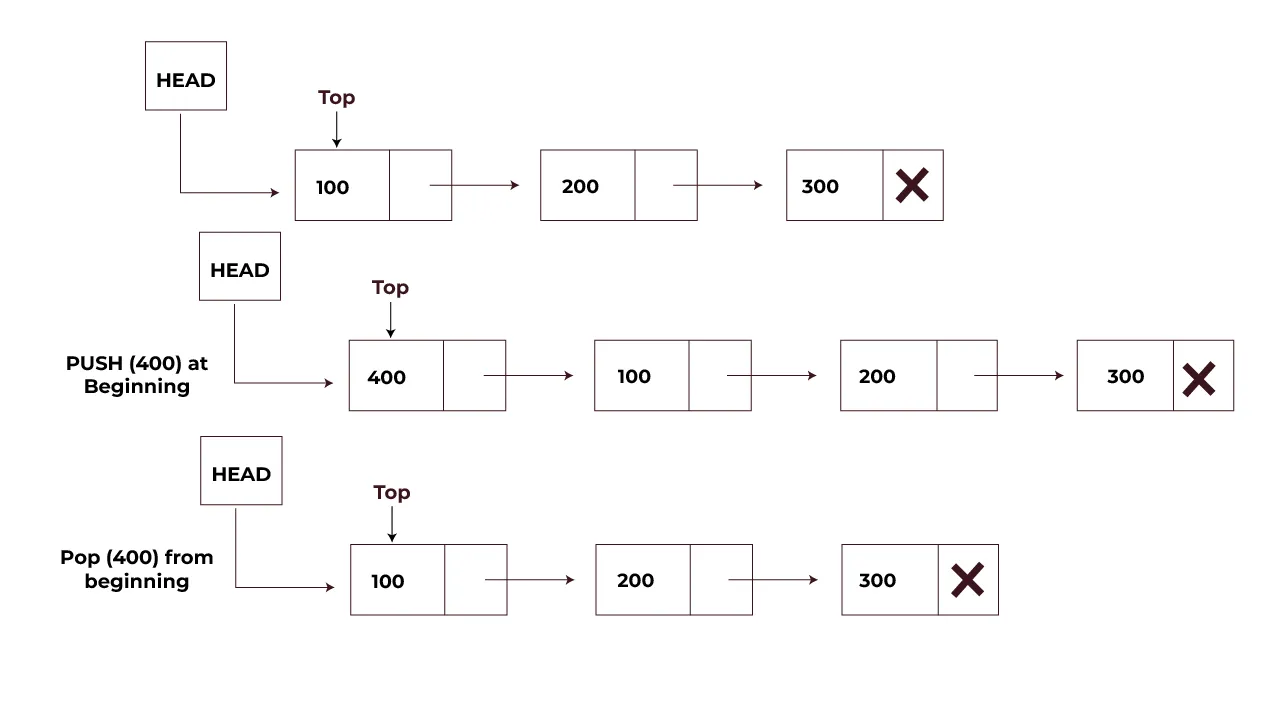
Linked List-Based Stack Implementation
class Node {
int data;
Node next;
Node(int data) {
this.data = data;
this.next = null;
}
}
public class Stack {
private Node top;
Stack() {
this.top = null;
}
void push(int data) {
Node newNode = new Node(data);
newNode.next = top;
top = newNode;
System.out.println("Push\t" + data + " pushed into stack");
}
String pop() {
if (top == null) {
return "Stack Underflow";
}
int popped = top.data;
top = top.next;
return String.valueOf(popped);
}
String peek() {
if (top == null) {
return "Stack is empty";
}
return String.valueOf(top.data);
}
boolean isEmpty() {
return top == null;
}
public static void main(String[] args) {
Stack stack = new Stack();
stack.push(10);
stack.push(20);
System.out.println("Peek\tTop element is: " + stack.peek());
System.out.println("Pop\tPopped element: " + stack.pop());
System.out.println("Is Empty\tStack is empty: " + stack.isEmpty());
}
}
Output:
Push 10 pushed into stack
Push 20 pushed into stack
Peek Top element is: 20
Pop Popped element: 20
Is Empty Stack is empty: false
In this example, the linked list allows the stack to grow dynamically, avoiding overflow. The code checks for underflow and handles it gracefully, making our stack robust and efficient.
Comparative Analysis of Array-Based vs. Linked List-Based Stack Implementations
When it comes to stack operations in data structures, choosing between an array-based and a linked list-based implementation can be tricky. Each has its pros and cons, and understanding these can help us make better decisions in our coding projects.
Let’s dive into the details and see how these two methods stack up against each other.
Array-Based Stack:
The Good:
- Simple and Fast: Array-based stacks are straightforward. The operations like push, pop, and peek are fast, with O(1) time complexity, since accessing elements by index is quick.
- Cache-Friendly: Arrays are stored in contiguous memory locations, which makes them more cache-friendly. This leads to better performance, especially in scenarios where speed is critical.
The Bad:
- Fixed Size: The biggest drawback of an array-based stack is its fixed size. If we declare a stack with a size of 1000 elements, we can’t add the 1001st element without causing an overflow. This limitation can be a real headache when we can’t predict how many elements we’ll need.
- Wasted Space: If we overestimate the required stack size, we end up wasting memory.
Unused slots in the array still occupy space, which is not ideal, especially in memory-constrained environments.
The Ugly:
- No Dynamic Growth: Unlike linked lists, arrays can’t grow or shrink dynamically.
We’re stuck with the size we initially declared, which can be either too large or too small for the actual workload.
Example Scenario:
Consider you’re developing a game with limited inventory slots. An array-based stack might work well here since the number of items is predefined and won’t change often.
Linked List-Based Stack:
The Good:
- Dynamic Size: Linked lists are inherently dynamic. This means we can keep pushing elements onto the stack without worrying about overflow as long as there’s available memory.
- Memory Efficient: Linked lists use only as much memory as needed. There’s no wasted space since each node is created dynamically as elements are added.
The Bad:
- Slower Access: Accessing elements in a linked list stack isn’t as fast as in an array.
Since each element is a node in a list, we can’t jump to an index directly, which slightly slows down operations. - More Memory Per Element: Each element in a linked list needs additional memory for the pointer that links it to the next node.
This overhead can add up, especially when dealing with large datasets.
The Ugly:
- Pointer Management: Working with pointers adds complexity. If we’re not careful, we could end up with issues like memory leaks or segmentation faults, making linked lists trickier to manage.
Example Scenario:
Consider a scenario where you’re handling a text editor’s undo feature. A linked list-based stack would be ideal since the number of undo steps isn’t fixed, and memory efficiency is crucial.
Head-to-Head Comparison:
Here’s a quick comparison of the two methods:
| Feature | Array-Based Stack | Linked List-Based Stack |
| Size | Fixed size | Dynamic size |
| Memory Use | Wasted space if over-allocated | No wasted space, but overhead per node |
| Access Speed | Fast (O(1)) | Slower due to pointer traversal |
| Ease of Use | Simple but inflexible | Flexible but more complex |
| Overflow | Can overflow if the array is full | No overflow as long as memory is available |
| Underflow | Both can underflow if not managed well | Both can underflow if not managed well |
Exploring the Time Complexity of Stack Operations and Why It Matters
Time complexity is a crucial factor when implementing stacks. It helps us understand how our code will perform as the size of the input grows.
Let’s break down the time complexities of the key operations in both array-based and linked list-based stacks.
Push Operation:
- Array-Based Stack:
- Time Complexity: O(1)
- Why? Because we’re just adding an element at the end of the array, which takes constant time.
- Linked List-Based Stack:
- Time Complexity: O(1)
- Why? We’re adding a new node at the beginning of the list, which also takes constant time.
Pop Operation:
- Array-Based Stack:
- Time Complexity: O(1)
- Why? Removing the top element simply involves decreasing the index, which is a constant time operation.
- Linked List-Based Stack:
- Time Complexity: O(1)
- Why? Popping the top node off the linked list is quick, as it’s just a matter of reassigning the top pointer.
Peek Operation:
- Array-Based Stack:
- Time Complexity: O(1)
- Why? We’re directly accessing the top element via its index.
- Linked List-Based Stack:
- Time Complexity: O(1)
- Why? The top element is directly pointed to by the top pointer.
Space Complexity:
- Array-Based Stack:
- Fixed size means space complexity is O(n), where n is the size of the array.
- Linked List-Based Stack:
- Space complexity is also O(n), but with an extra space for the pointers, making it slightly more memory-intensive.
Real-World Applications of Stacks in Various Programming Scenarios
Stacks are more than just a neat concept; they have real-world applications that solve significant problems.
Let’s explore a few scenarios where stacks come into play.
Infix to Postfix/Prefix Expression Conversion
In many programming tasks, we need to convert expressions from infix to postfix or prefix notation. This is particularly useful in compilers, where expressions are evaluated in a different order than they appear.
Example:
Consider the expression A + B * C.
In infix, it’s written just as shown. But in postfix, it’s ABC*+, which reflects the order of operations without needing parentheses.
Stacks make this conversion straightforward by holding operators until they’re needed, ensuring that operations are performed in the correct order.
Managing Function Calls and Recursion Using Stacks
Every time a function is called, the current state needs to be saved so that when the function completes, the program can return to where it left off.
This is handled by the call stack, a fundamental part of how modern computers work.
Example:
Imagine a recursive function to calculate the factorial of a number.
Each function call is pushed onto the stack, and as the function resolves, it’s popped off, returning control to the previous state. Without stacks, managing recursion would be a nightmare, leading to errors and unpredictable behaviour.
Implementing Undo/Redo Functionality in Software Applications
Stacks are the backbone of undo/redo functionality in applications like text editors or graphic design tools.
Every action we perform is pushed onto a stack. When we hit undo, the last action is popped off, reverting the application to its previous state.
Example:
In a text editor, each keystroke or formatting change is an action pushed onto the stack. Hitting undo pops the last action, while redo re-applies it by pushing it back onto the stack.
Depth-First Search (DFS) in Graph Theory with a Code Example
Depth-First Search (DFS) is a popular algorithm used in graph theory to traverse or search through a graph.
It’s particularly useful for finding connected components in a graph or solving maze problems.
Example:
import java.util.*;
public class DFSUsingStack {
// Method to perform DFS traversal using a stack
public static void DFS(int start, List<List<Integer>> adjList, boolean[] visited) {
Stack<Integer> stack = new Stack<>();
stack.push(start);
while (!stack.isEmpty()) {
int node = stack.pop();
if (!visited[node]) {
System.out.print(node + " ");
visited[node] = true;
}
// Push neighbors onto the stack in reverse order to get the desired DFS order
List<Integer> neighbors = adjList.get(node);
for (int i = neighbors.size() - 1; i >= 0; i--) {
int neighbor = neighbors.get(i);
if (!visited[neighbor]) {
stack.push(neighbor);
}
}
}
}
public static void main(String[] args) {
int n = 5; // Number of nodes
List<List<Integer>> adjList = new ArrayList<>(n);
for (int i = 0; i < n; i++) {
adjList.add(new ArrayList<>());
}
adjList.get(0).add(2);
adjList.get(0).add(1);
adjList.get(1).add(4);
adjList.get(1).add(3);
adjList.get(1).add(0);
adjList.get(2).add(0);
adjList.get(3).add(1);
adjList.get(4).add(1);
boolean[] visited = new boolean[n];
System.out.println("DFS traversal starting from node 0:");
DFS(0, adjList, visited);
}
}
Output Example:
DFS traversal starting from node 0:
0 2 1 4 3
This example shows how a stack helps in traversing a graph by exploring as far as possible along each branch before backtracking.
Parentheses Matching in Compilers and Syntax Parsers
Compilers often need to check if parentheses in expressions are balanced.
Stacks make this job easy by pushing opening brackets onto the stack and popping them when a matching closing bracket is found.
Example:
import java.util.Stack;
public class BalancedParentheses {
// Method to check if the expression has balanced parentheses, brackets, and braces
public static boolean isBalanced(String expression) {
Stack<Character> stack = new Stack<>();
for (char ch : expression.toCharArray()) {
if (ch == '(' || ch == '{' || ch == '[') {
stack.push(ch);
} else if (ch == ')' || ch == '}' || ch == ']') {
if (stack.isEmpty()) {
return false;
}
char lastOpened = stack.pop();
if (!isMatchingPair(lastOpened, ch)) {
return false;
}
}
}
return stack.isEmpty();
}
// Helper method to check if the pair of characters matches
private static boolean isMatchingPair(char open, char close) {
return (open == '(' && close == ')') ||
(open == '{' && close == '}') ||
(open == '[' && close == ']');
}
public static void main(String[] args) {
System.out.println(isBalanced("(a+b) * [c+d]")); // Output: true
System.out.println(isBalanced("(a+b] * {c+d}")); // Output: false
}
}
This function ensures that every opening bracket has a corresponding closing bracket, a vital step in parsing code.
Advantages and Disadvantages of Using Stacks in Data Structures
When we talk about stack operations in data structures, it’s not all sunshine and rainbows. Like every tool in programming, stacks have their strengths and weaknesses.
Understanding these can help us decide when to use them and when to consider alternatives.
Advantages of Using Stacks
1. Simple and Easy to Implement:
Stacks are straightforward. Whether we use arrays or linked lists, the operations are intuitive and quick to code.
This simplicity makes stacks a great starting point for beginners in data structures.
2. Efficient Memory Usage:
In linked list implementations, stacks use only as much memory as needed. There’s no waste, making them ideal for applications where memory efficiency is crucial.
3. Last-In, First-Out (LIFO) Order:
The LIFO nature of stacks is perfect for problems where the most recent data needs to be accessed first. This is why stacks are integral to managing function calls, undo operations, and more.
4. Supports Backtracking:
Stacks are great for tasks that require backtracking.
Algorithms like Depth-First Search (DFS) rely on stacks to remember previous states and navigate complex structures like mazes or graphs.
5. Wide Range of Applications:
From parsing expressions to implementing undo/redo features in software, stacks are versatile. Their broad range of uses makes them a go-to data structure in many programming scenarios.
Disadvantages of Using Stacks
1. Limited Access to Elements:
Stacks restrict access to only the top element.
If we need to access an element that’s not on top, we have to pop all elements above it, which isn’t efficient.
2. Fixed Size in Array-Based Implementations:
When using arrays, stacks have a fixed size. This means we can’t add more elements once the stack is full, leading to potential overflow errors.
3. Overflow and Underflow Issues:
Both overflow (in arrays) and underflow (in both arrays and linked lists) can cause errors. These issues need to be handled carefully to avoid crashes or unintended behaviour.
4. More Memory Per Element in Linked Lists:
In linked list implementations, each element requires extra memory for the pointer. This overhead can become significant, especially with large stacks, leading to increased memory usage.
5. No Random Access:
Unlike arrays or lists, stacks don’t allow random access to elements. We can only interact with the top element, which limits flexibility in certain scenarios.
Conclusion
Stack operations in data structure is a fundamental concept with a unique LIFO property which is essential for many algorithms and applications. They’re easy to implement, efficient with memory, and versatile.
But they also come with limitations, like restricted access and potential overflow issues.
When deciding whether to use a stack, it’s crucial to consider the specific needs of the problem. If we need quick access to the most recent data or require a structure for backtracking, stacks are an excellent choice.
However, if we need random access or a dynamic size, other data structures might be more suitable.
Best Practices:
- Always handle edge cases like overflow and underflow, especially in array-based stacks.
- Use stacks for problems that align with their LIFO nature, like function call management or expression evaluation.
- Choose the right implementation (array or linked list) based on the requirements for memory efficiency and flexibility.
By keeping these points in mind, we can leverage stacks effectively and avoid common pitfalls.
What are the main differences between stacks and queues?
Can stacks be implemented using other data structures like trees?
Why are stacks preferred for managing function calls and recursion?
How can I prevent stack overflow in my programs?
Updated on August 21, 2024
